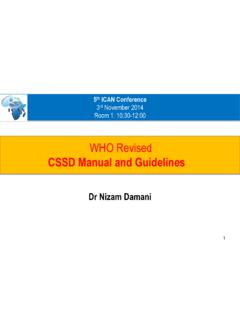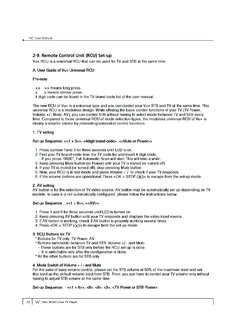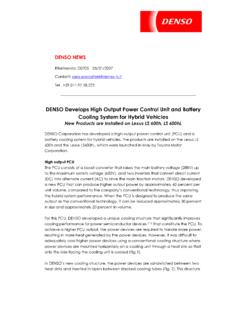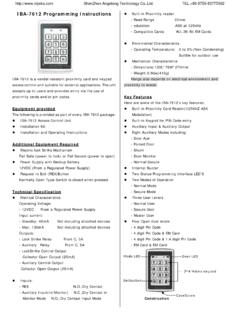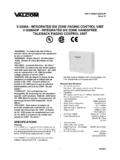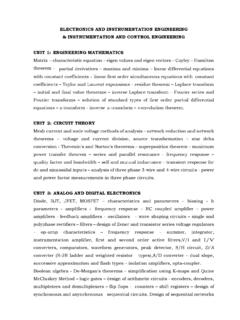Transcription of Infection Prevention and Control in Dialysis Unit
1 17-Dec-145th ICAN Conference 2014 in Harare, Zimbabwe1M O U S T A F A A B D E L N A S S E R , I C A N B O A R D M E M B E RINFECTION Prevention AND Control IN Dialysis UNITINTRODUCTION Haemodialysis(HD)and peritoneal Dialysis is a lifeline for patients with end stage renal disease (ESRD)or renal failure and are awaiting kidney transplant. Dialysis patients are at high risk of Infection because of underlying illness and numerous environmental and procedural illnesses. Establishing a comprehensive Infection Prevention and Control (IPC) program for Dialysis settings will reduce the Infection risks for both patients and healthcare workers (HCWs).
2 17-Dec-145th ICAN Conference 2014 in Harare, Zimbabwe2 OBJECTIVE To overview the multiple infections transmitted/ induced in Dialysis patients. To stress on the essential elements of IPC program in Dialysis units. 17-Dec-145th ICAN Conference 2014 in Harare, Zimbabwe3 DEFINITIONS Central Venous Catheter (CVC): CVC is only intended for short term access use for HD in an emergency, while awaiting a fistula to heal or in preparation for a graft. It carries the highest risk of Infection . Standard care procedures must be followed to reduce the risk of : A connection surgically created between an artery and vein (usually in the arm).
3 It is accessed via a needle for HD. It has the lowest risk of Infection . Vascular graft: An artificial tube surgically placed between an artery and vein (usually in the arm). This graft is accessed via a needle for HD. It carries an intermediate risk of Infection . 17-Dec-145th ICAN Conference 2014 in Harare, Zimbabwe4 Dialysate: A balanced electrolyte solution which is introduced on one side of the semi-permeable dialysermembrane (opposite to the patient s blood) to exchange solutes with blood during HD. Dialysis water: Purified water that is used to mix the dialysate or to disinfect, rinse, or reprocess the dialyser.
4 Dialyser: A part of the HDmachine; it has two sections separated by a membrane. The patient s blood flows through one side and the dialysate flows through the other side. 17-Dec-145th ICAN Conference 2014 in Harare, Zimbabwe5 DEFINITIONS (CONT )Reverse osmosis (RO): A process used to purify Dialysis water by removing dissolved inorganic solutes as well as bacteria and their Dialysis (PD) : PDinvolves Dialysis fluid instilled via a surgically inserted PDcatheter into the peritoneal space of the abdomen. Most catheters are made from silicone.
5 The fluid is removed, taking with it any toxins. Most common types of PDinclude chronic ambulatory, continuous cyclical and chronic intermittent PD. 17-Dec-145th ICAN Conference 2014 in Harare, Zimbabwe6 DEFINITIONS (CONT )17-Dec-145th ICAN Conference 2014 in Harare, Zimbabwe7 UNDERLYING DISEASES OR CONDITIONS PRECIPITATING TO infections IN Dialysis PATIENTS Diabetes Hypertension Cardiovascular disease Immunosuppressive therapy Other critical diseases Direct access into normally sterile areas. Contamination:at various steps in the Dialysis procedure (extrensic) or of any of the components of the Dialysis system(intrinsic).
6 17-Dec-145th ICAN Conference 2014 in Harare, Zimbabwe8 THE MOST COMMON TYPES OF Dialysis -ASSOCIATED infections Access site infections Bacteremias Peritonitis Pyrogenic reactions infections with blood-borne pathogens17-Dec-145th ICAN Conference 2014 in Harare, Zimbabwe9 Infection -ASSOCIATED RISKS Hepatitis B Hepatitis C Acquired immune defi ciency syndrome (AIDS) Bacterial disease Fungi Mycobacteria 17-Dec-145th ICAN Conference 2014 in Harare, Zimbabwe10 HEPATITIS B Hepatitis B virus (HBV) is transmitted through percutaneous or permucosalexposure to the blood of infected patients (HBsAg-positive or HBeAg-positive).
7 HBV remains viable at room temperature for at least 7days HBV has been detected on: clamps, scissors, and external surfaces and parts of Dialysis machines. HBV can be transmitted to patients or staff on gloves or unwashed ICAN Conference 2014 in Harare, Zimbabwe11 HEPATITIS C HCV is transmitted by percutaneous exposure to infected blood. Factors that increase HCV Infection in HD patients of blood transfusions, of blood transfused, and on HD. IPC practices. Transmission of HCV through: equipment and supplies not disinfected between patients, of common medication carts, multi-dose medication vials, HD machines, related equipment & blood ICAN Conference 2014 in Harare, Zimbabwe12 ACQUIRED IMMUNE DEFICIENCY SYNDROME (AIDS) Human immunodeficiency virus (HIV) is transmitted by blood or blood-containing body fluids.
8 There have been very few reports of HIV transmission in Dialysis and these resulted from inadequate disinfection of equipment, including access. 17-Dec-145th ICAN Conference 2014 in Harare, Zimbabwe13 BACTERIAL DISEASE Increased risk of Infection and colonisationwith multi-drug resistant organisms (MDRO), such as Staphylococcus aureus (MRSA) and vancomycin-resistant enterococci (VRE). Vancomycinuse is high in Dialysis populations. Outbreaks of MRSA in some Dialysis units from colonised\infected patients. MDR Gram-negative infections as Pseudomonas aeruginosa, Stenotrophomonasmaltophilia, and Acinetobacterspp17-Dec-145th ICAN Conference 2014 in Harare, Zimbabwe14 MYCOBACTERIA Reports of mycobacterial infections in Dialysis patients from contaminated water.
9 High-risk for progression from latent tuberculosis to active TB disease. Frequent hospitalisationof Dialysis patients increases the risk of transmission of TB to other patients or to ICAN Conference 2014 in Harare, Zimbabwe15 FUNGI Dialysis patients are susceptible to fungal infections such as Aspergillusspp. In addition, there is a risk of Candida bacteraemiaand peritonitis with the patient s skin as a ICAN Conference 2014 in Harare, Zimbabwe1617-Dec-145th ICAN Conference 2014 in Harare, Zimbabwe17 Basic Principles of IPC in Dialysis Unit1-SURVEILLANCER outine testing / or documentation for: HBV , HCV & HIV as soon as, it is anticipated that Dialysis is required & every 3 months, for : HBsAg, HCV & HIV antibody Patient s vaccination ( HBV).
10 Bacteraemia, access site infections , and peritonitis. Treatment station used and machine number, as well as namesof staff connecting and disconnecting the patient. This information will be useful in any outbreak ICAN Conference 2014 in Harare, Zimbabwe182-STANDARD AND TRANSMISSION-BASED PRECAUTIONS Segregation of HBsAg-positive patients and their equipment and supplies from those used for non-HBV-infected patients. Patients with either HCV or HIV Infection also require a dedicated machine. Contact Precautions for MDRmicroorganisms, such as MRSA and VRE, and Gram negative ICAN Conference 2014 in Harare, Zimbabwe192-STANDARD AND TRANSMISSION-BASED PRECAUTIONS (CONT ) Proper hand hygiene (HH) (as WHO s 5 moments).
